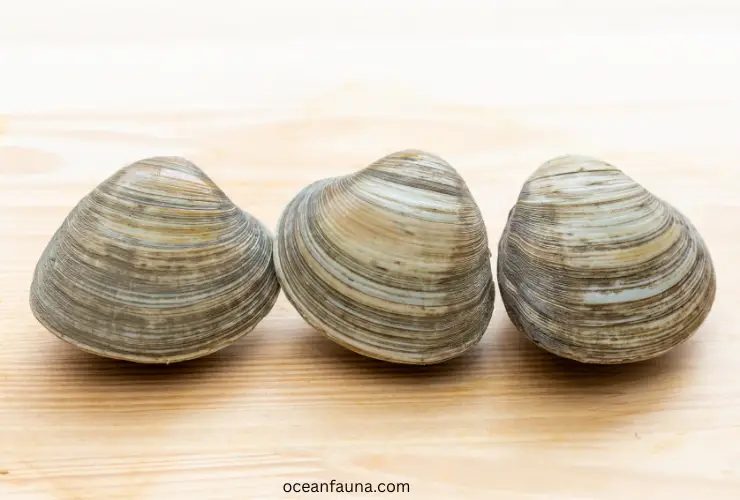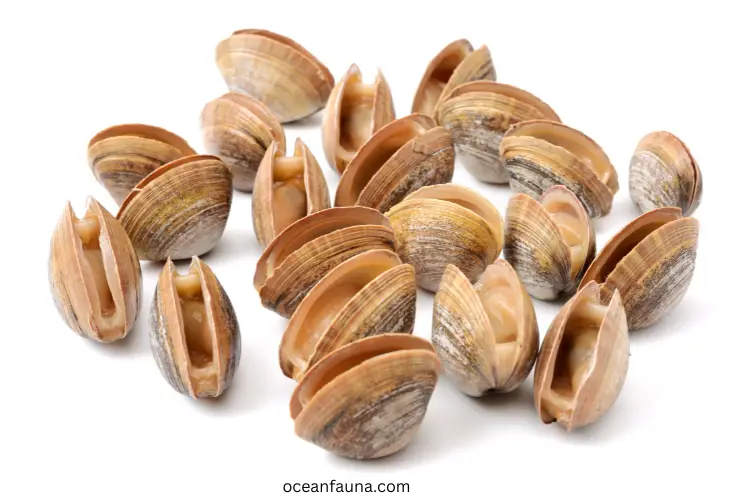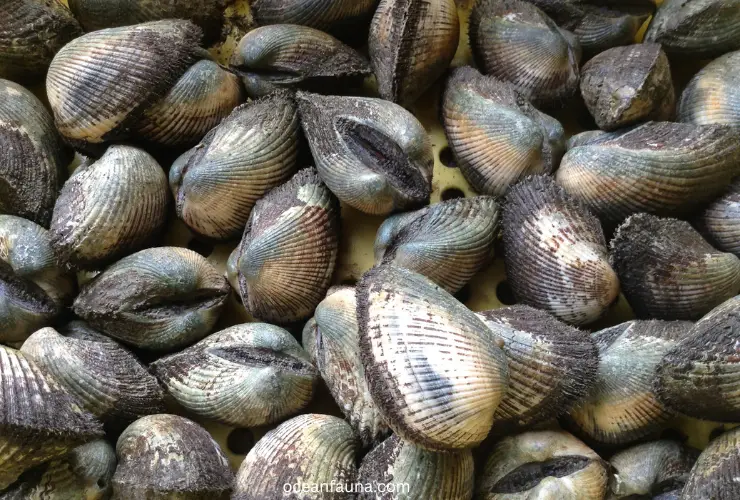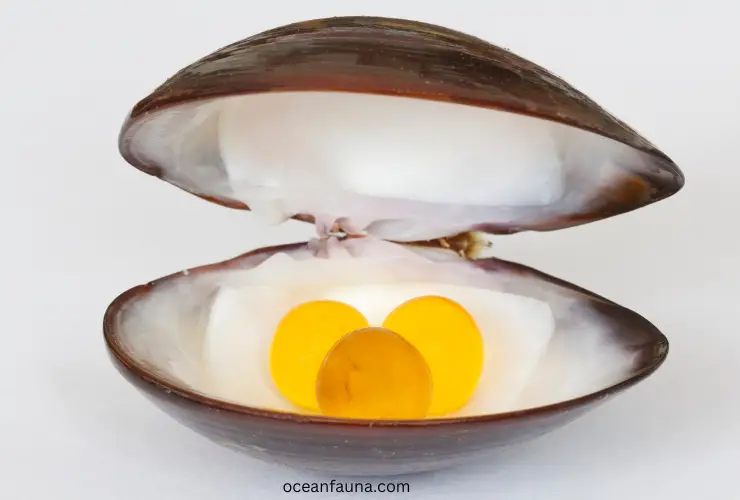Hard clams, also known as quahogs, are fascinating bivalve mollusks. They can be found in shallow coastal waters across the world. They are a valuable human food source, often harvested commercially for their meat.
They are known for their rigid, protective shells, which hide a tender, flavorful interior that can be prepared in various ways.
However, there’s more to these creatures than just their culinary uses. Hard clams have played an essential role in coastal communities’ cultural and economic history. They have been used as currency, traded among Native American tribes and early settlers, and even served as the basis for local economies in some areas.
Hard clams have unique adaptations and behaviors that allow them to survive and thrive in their environment. They also play an essential role in filtering water and providing food for other marine animals. So, if you want to learn more about these fascinating creatures and their world, stick around! There’s much to discover.
About Hard Clam – A Quick Biology
Let’s take a quick peek at this captivating species.
| Parameters | Details |
| Scientific name | Mercenaria mercenaria |
| Kingdom | Animalia |
| Family | Veneridae |
| Genus | Mercenaria |
| Phylum | Mollusca |
| Class | Bivalvia |
| Order | Venerida |
| Species | Mercenaria |
| Habitat | Salty waters |
| Life Span | Up to 40 years |
| Diet | Phytoplankton |
| Geography | America, Europe |
| Other names | Quahog, Round clam, Chowder clam |

Geographic Distribution – Where do Hard Clams Live?
Hard clams are found in North America and Central America. They are native to areas from Prince Edward Island to the Yucatán Peninsula and along the eastern seaboard of the United States from Florida to Canada.
They live in estuarine and coastal waters from the Gulf of St. Lawrence to the Gulf of Mexico and the Caribbean Sea. They are most commonly found between Cape Cod and New Jersey, where plenty exists. However, they have also been introduced to California and several European countries.
Appearance of Hard Clam
Hard clams can be easily recognized by their thick, triangular shell that is roughly triangular. Their shell is divided into two halves or valves. Both halves are held together by a stretchy ligament at the hinge.
The hard clam’s shell can be light brown to grey with a purple border. It may have different bands closer together near the edges and further apart near the center.
As the hard clam grows, it develops thin ridges on its shell that are sharp at first but wear away over time. It can grow about 12cm long, and its beak stretches outside the main shell. Each valve, or half of the shell, has three teeth.
The hard clam has a distinct internal anatomy. Inside the shell, you’ll find a thick, fleshy mantle that produces the shell. The shell’s inside is shiny with a blueish-purple color around the muscle scars.
It features two siphons, which are tubes extending from the body through a hole in the shell. They are joined together with tentacles around the incurrent siphon. The incurrent siphon draws in water, while the excurrent siphon expels water and waste.
They can be yellow or brown-orange at the ends with dark brown or opaque white streaks. The hard clam also has a large, white, muscular foot located at the bottom of its body.
Behavioral Adaptations of Hard Clam
These clams live in both intertidal and subtidal areas and are known for their sessile lifestyle. They feed on the ocean floor using their siphons to take in water and food particles that are filtered through their gills.
To avoid predators, hard clams have a range of defense mechanisms. Their thick, rounded shells provide excellent protection from predators. When disturbed, hard clams can quickly close their shells to protect their softcore from predators, keeping them safe in their burrows.
Moreover, hard-shelled clams have muscular feet that allow them to dig into the sediment at the bottom of their habitats. This helps them maintain a stable position in the water.
On average, hard clams can bury to a depth of 2 cm in the sand and 1 cm in the mud. Interestingly, smaller individuals burrow more in-depth than bigger ones. These specific preferences and unique adaptations enable hard clams to thrive in their environment.
Habitat and Range – Is a Hard Clam a Saltwater Fish?
Hard clams have specific preferences for their habitat and water conditions. They like sandy or muddy bottoms. Plus, they thrive in saline water and cannot survive in water with low salt levels. They can tolerate a range of saltiness levels. However, they do best in waters with a salinity of 20 to 30 parts per thousand (ppt).
Feeding/Diet—Are Hard Clam Carnivores, Herbivores, or Omnivores?
Hard clams are omnivores. They are filter feeders that consume small food particles, primarily phytoplankton (single-celled algae), zooplankton, benthic diatoms, and dissolved organic matter. They can filter 7-8 liters (nearly 2 gallons) of water per hour.
In their larval stage, hard clams primarily eat plankton, including small organisms such as algae and tiny animals. After reaching adulthood, they continue to consume similar food items and larger food particles, such as shrimp and small fish, as they grow. (Source)

Spawning and Reproduction – Do Clams Have Internal or External Fertilization?
According to SARC, hard clams become sexually mature at a shell length of almost 35 mm (1.4 inches). The sexes of hard clams are distinct but are externally undifferentiable.
Reproduction occurs between May and October when water temperatures reach 68 ℉ – 73 ℉. However, this varies slightly based on location and species.
The first phase in the hard clam’s reproductive cycle is that each parent releases either eggs or sperm into the water. The gametes are released in the gonads, which are sack-like organs that carry the gametes.
These gonads then open up so external fertilization can occur. In the gonads, there are gonopore’s that allow the gametes to be released into the water.
Fertilization occurs when sperm and eggs combine in the water column. After fertilization, the egg develops into a planktonic larva that settles on the sediment and metamorphoses into a juvenile clam.
Growth- How Long Does it Take a Hard Clam to Grow?
Hard clams grow slowly. It takes them about 2 to 3 years to reach 1 to 2 inches. They typically have a meat weight of 18 to 20 grams at this size.
Hard clams have a long lifespan, averaging 12–20 years, but some may live up to 40 years. Their growth rate slows as they age, and they may only grow to be 3 inches long in 7 to 8 years.
Predators: Who Eats Hard Clam?
Like many other species in the marine ecosystem, hard clams are not immune to predators. Some of the hard clam’s main predators include gastropods and crabs, which typically prey on small clams.
According to a study conducted by the Town of Islip, NY, the principal predators of hard clams in the area are blue crabs, knobbed whelks, and oyster drills.
Hard Clams’ Significance
According to the Journal of Shellfish Research, the only type of shellfish that is caught for commercial purposes from the Rehoboth and Indian River Bays are hard clams. They have a high market value. They are also raised on farms along the East Coast.
Hard clams are sold in three categories based on size:
- Littlenecks are the smallest and most expensive.
- Cherrystones are medium-sized.
- Chowders are the largest and the least expensive. They are typically sold for clam chowder.
In addition to their commercial importance, hard clams also play a significant role in the marine ecosystem. They are suspension-feeding benthic fauna. They help maintain water quality by filtering out particles and excess nutrients from the water column. Hard clams are also important food sources for many predators, including humans, birds, and fish.

Population of Hard Clam
According to research, hard clam populations in Great South Bay declined rapidly from the 1970s to the mid-1980s due to overfishing. During this period, the town’s inability to impose significant changes in hard clam harvest management contributed to the decline. This made the resource commercially unviable in the mid-1990s.
Moreover, a mysterious threat, known as QPX or “quahog parasite unknown,” caused clam deaths by the thousands. Additionally, hard clams are susceptible to infectious diseases such as Perkinsus. (Source)
How Do Hard Clams Move?
According to the Cambridge University Press, hard clams use their muscular feet to move through the sand or mud where they live. They push their foot into the sediment and contract it, pulling their shell forward a small distance. They repeat this process, slowly moving along the sand or mud surface.
This method of movement is called “burrowing,” and it allows hard clams to move from one spot to another, find food, and avoid predators. It also helps them maintain contact with water, which they need to survive.
What Are the Different Types of Hard Clams?
Hard clams have other names depending on their size, including littlenecks, top necks, cherrystones, and chowders.
- Littleneck Clams: These are the most undersized hard clams, only 1 to 2 inches long. They are often served raw on the half shell or used in clam chowder.
- Cherrystone Clams: These are medium-sized clams, measuring around 2 to 3 inches. They’re often served raw on the half shell or steamed with butter and herbs.
- Topneck Clams: These are larger than littleneck and cherrystone clams, measuring around 3 to 4 inches long. They are often used in stews and soups.
- Chowder Clams: These are the giant hard clam, measuring around 4 inches or more. They are commonly used in clam chowder or fried clam dishes.

FAQs
Can You Eat Hard Clams?
Yes, hard clams are popular seafood and are safe to eat. They are often eaten raw but can be steamed, boiled, fried, or baked.
They are commonly harvested for human consumption. Also, they are available in various seafood dishes, such as clam chowder, cakes, and steamed clams. They have a slightly sweet and salty flavor that pairs well with garlic, lemon, and other herbs and spices.
Are Hard Clams Safe to Eat?
Hard clams are generally considered safe to eat when cooked properly. However, they can sometimes include harmful bacteria or toxins, primarily if they are harvested from polluted waters. It’s crucial to ensure hard clams are harvested from clean, safe waters.
How Are Hard Clams Harvested?
Hard clams are typically harvested by digging them out of the sediment where they live. This can be done using rakes or dredges dragged along the ocean floor to collect the clams. Hard clams are also sometimes grown commercially in aquaculture farms.
Are Hard Clams Endangered?
Hard clams are not considered an endangered species. In fact, they are one of the most commercially important shellfish species in the United States.
However, like any living organism, they can be affected by environmental changes, pollution, overharvesting, and other factors. It is essential to manage their populations and habitats to ensure their sustainability for future generations.
Are Hard Clams Sustainable to Eat?
Hard clams are considered a sustainable seafood option, as they are plentiful and have a relatively low environmental impact.
Conclusion
Hard clams are a delicious and versatile seafood option that people have enjoyed for centuries. They are a healthy source of protein, vitamins, and minerals. They can be cooked in various ways to suit any taste preference.
But did you know that hard clams also play an essential role in environmental science? They’re used to check water quality and are super sensitive to environmental changes.
Hard clams can be a warning sign if any pollution or other hazards are present. And they’re not just good at detecting problems – they also help maintain the health of our coastal ecosystems by filtering up to 24 gallons of water a day.

